Tracking down Steve Vai's elusive "Crossroads" Jackson – the most famous guitar that was never heard
How an epic 20-year quest to find the red Jackson Vai played as Jack Butler in the movie Crossroads led to the ultimate replica headcutter
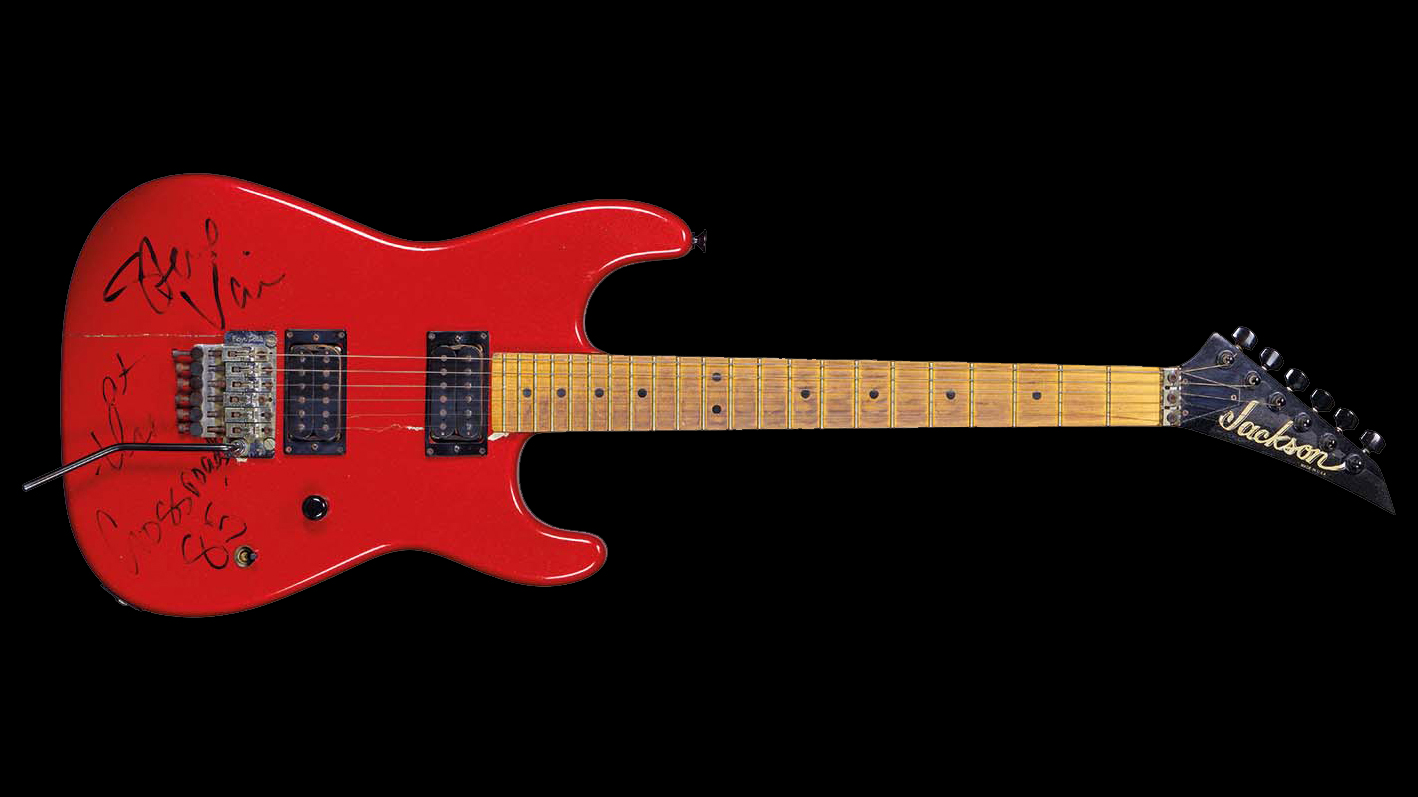
When I began writing for Guitar World in 2001, the job expectedly required a great deal of research, fact checking, etc. And the internet was really only a few years old. As I searched for details about various gear and artists, I frequently saw fans passionately arguing over the Jack Butler guitar.
I couldn’t believe how many divergent opinions were shared about who built it, what happened to it, the likely specs, which pickups were in it, etc. Suffice to say, the online fervor rekindled my own passion for the instrument and began a mild-mannered pursuit that quickly morphed into a monstrous 20-year quest.
It seemed logical to start my search with the one person most likely to know the guitar’s history and progression of ownership: that’s right, Steve Vai, aka Jack Butler, himself. Of course, It wasn’t as simple as just picking up the phone, and I was keenly aware that leveraging my probationary position with the magazine – under the guise of writing an article that was not yet approved or even pitched – placed me on shaky ground.
This wasn’t quite as dishonest as it sounds, because any good journalist is going to research stories that might not be accepted/published. That was my prepared response, but I knew that if anyone actually bothered to call my bosses, it would be readily apparent that my venture was as much personal as it was professional.
Undeterred, I eventually found my way to Vai’s manager and carefully crafted a letter that I hoped would spark his interest. Approximately a month passed and I sheepishly followed up by email several times. Then, one day, I opened my inbox to see that Vai had replied to my query.
He couldn’t have been more kind, basically saying he had no recollection of what he did with the guitar after shooting and couldn’t begin to speculate on its whereabouts. In later communications, he said Grover Jackson gave him the guitar prior to being cast in the film and that he brought it to the set thinking that its red sparkle color and style would suit the theme and character.
As we exchanged a few more emails, he said he’d be happy to do a short interview about the movie and even offered to personally go through his vault in search of the guitar; Vai’s own curiosity was admittedly piqued.
Get The Pick Newsletter
All the latest guitar news, interviews, lessons, reviews, deals and more, direct to your inbox!
When I asked Vai about the Jackson’s pickups, he didn’t know what they were, but he proffered that he likely used DiMarzio PAFs or PAF Pros to record his parts – the question about which pickups were in the Jack Butler Jackson and which were used to record his parts are among the most highly discussed by fans online.
It’s important to clarify here that the Green Meanie guitar he used to record his parts in Crossroads was recently confirmed to have a basswood body with DiMarzio PAF Pro pickups. However, the PAF Pros may not have been in the guitar when Vai recorded the Crossroads pieces, which likely happened between the end of Alcatrazz’s 1985 tour and the beginning of rehearsals with the David Lee Roth band in 1986.
Fans are also aware that Vai experimented with the DiMarzio X2N during his Alcatrazz days, making it another possibility for the recording. The final consensus among Vai, DiMarzio’s Steve Blucher and myself is that PAF Pros were the most likely pickups on the recording.

But which pickups were in the Jack Butler Jackson? The answer: Jackson pickups! There was a ceramic, high-output J-90C in the bridge and an Alnico J-80 in the neck position. The dark magnets and bobbin sheen gave them a menacing look, unlike anything else on the market, and since Jackson built the guitar, it makes perfect sense that they’d use their own pickups. Ultimately, Vai suggested I next speak to Arlen Roth and Grover Jackson.
Arlen Roth didn’t know what happened to the original red Jackson. What he did say was that there were many copies made for Vai to drop
A great deal has already been published about Roth’s extensive, albeit unofficially credited, contributions to the film’s slide guitar playing and his training of Ralph Macchio. But Roth was nice enough to speak with me for a couple of hours about these fabulous stories, including a fond anecdote about a day off from filming where the cast formed a softball team called the Crossroads Crushers.
Back to my primary question: he didn’t know what happened to the original red Jackson. What he did say was that there were many copies made for Vai to drop, some with the paint still wet and some that crew members took home (in broken bits and pieces).
On the suggestion of Roth, I contacted a well-known Jackson collector in Southern California who proved to have a great deal of knowledge about all things Jackson Guitars. He was certain that either Grover Jackson or Mike Shannon built the guitar; Shannon was one of Grover Jackson’s original employees in the heyday of Charvel SuperStrats and is most noted for building Randy Rhoads’ offset Concorde V.
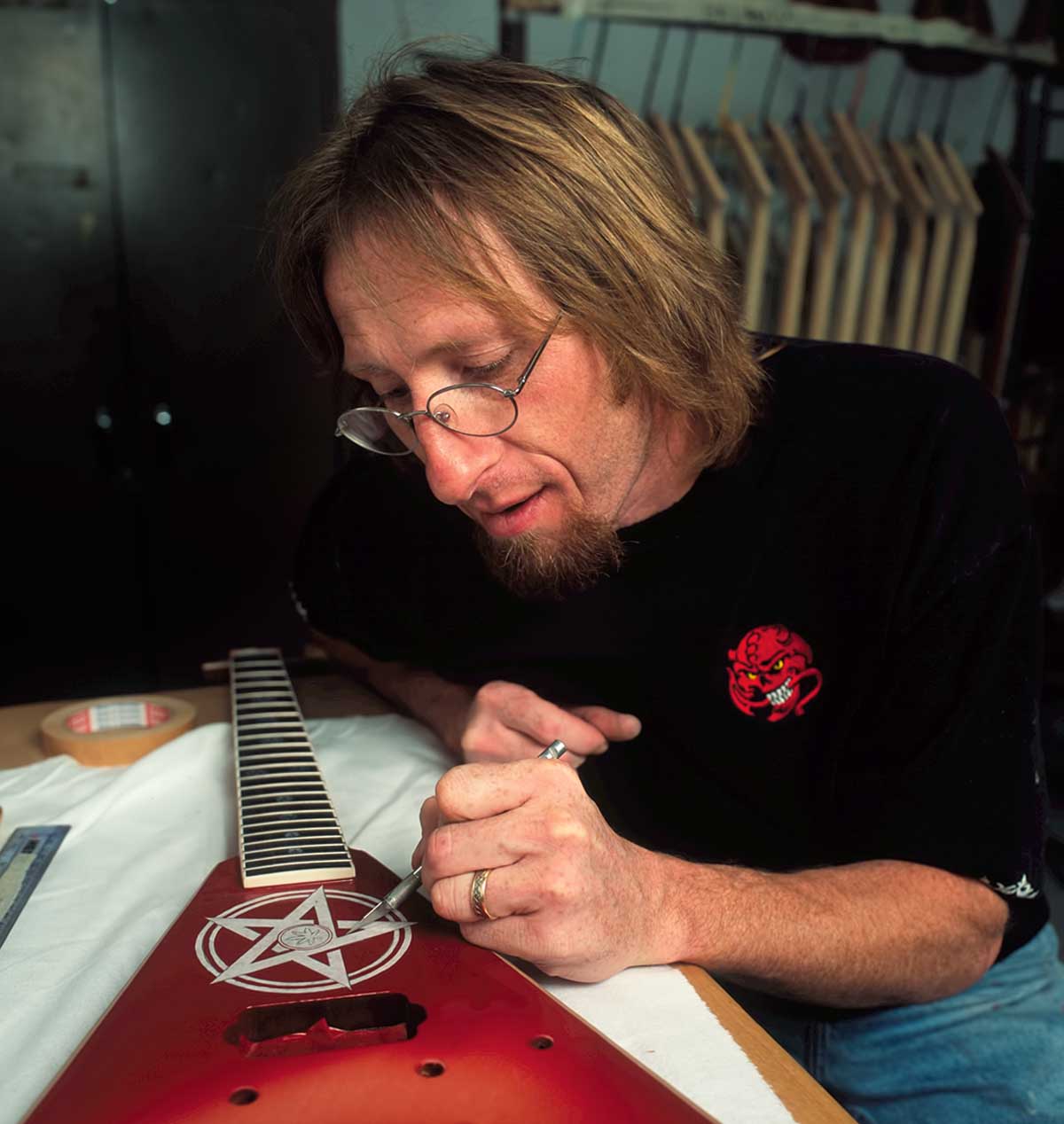
He said Mike was still building guitars, then for the Fender Custom Shop, and that I should also consider contacting a Jackson aficionado in Sweden, who was known to have one of the most extensive collections of rare and obscure Charvels and Jacksons. I emailed the collector, but after several months of waiting, I didn’t receive a reply.
Around this same time, I came across an online discussion board, where someone had posted a photo of the Jack Butler guitar at the Houston Hard Rock Cafe. I later learned it was previously displayed at the Las Vegas HRC. It was signed “Steve Vai at the Crossroads 85.”
Finally, by a stroke of sheer luck, I’d found it – a true Eureka moment! All I had to do was contact the Hard Rock Cafe’s corporate headquarters and ask for the details. Right? Wrong. I should’ve known it wasn’t going to be this simple… they confirmed that it was in their collection at one time but that they no longer had it and that no further information was available. Just like that, it was lost again – a dead end. By now, it was 2003 – time to call Jackson Guitars directly.
Thinking I might never find the original, I also decided to build an exact replica for myself and use it in the article that I hoped Guitar World would someday print. After quite a few phone calls and emails, I made my way to one of Jackson’s production heads. He said, “If we can just get the serial number or work-order number (from inside the tremolo cavity), we can easily track it down in the Jackson records.”

He was also onboard with building a replica and pleased to put me in touch with Mike Shannon. Mike got on the phone and discussed at length all of the likely details, using his memory of how they did things at Jackson in 1985. Mike also suggested I contact Grover Jackson directly, who was – at the time – running a CNC shop in Fullerton, California; Grover is now the luthier and mastermind behind Dave Friedman’s heralded high-end guitar line.
Grover didn’t have a strong recollection of the guitar but told me the body was definitely swamp ash and that there were multiple other guitars made to resemble the original; this jived perfectly with what Arlen told me. At about this time, I also learned that only one of the copies was spot-on to the original, which made me believe I may be chasing two guitars, without any way to know which one was the original.
Then I received an unexpected email. It was from the Swedish collector, who confirmed that he never owned the guitar but recently saw it at the Hard Rock Cafe in Queenstown, New Zealand. It was another “aha!” moment, and it certainly warranted a pricey phone call.
It was common practice for neckplates to be reused, perhaps when a guitar was destroyed or disassembled, and then used on another guitar. So the original Jack Butler guitar is officially and appropriately a ghost in the system. It never happened
“G’day, mate. Rock and love. Welcome to our pub!” was the Aussie-fueled greeting I received. After identifying myself and the guitar I sought, the manager said, 'Sure, I’m looking at it right here. She’s a beauty, mate. What can I do for you?' I explained that I’d been tracking the guitar’s history for some time and planned to rebuild the guitar for a story in Guitar World… so I just needed a few pics and the serial number off the neck plate.
“Can’t help you, mate. They’d have me arse if I took it off the wall.” I said, “Look, it took me years to get this far; there must be something we can do to make this happen. Name your price.” He said, “Well, we’re huge fans of your mag here, so send us a box of Guitar World T-shirts and toppers [baseball caps], and you’ll have your photos.” That’s it? I thought. Some merch and swag are all they want? I confidently replied, “No problem, they’re in the mail.”
Of course, there was a problem: I had no authority whatsoever to send a box of Guitar World swag to anyone, and especially not gratis. So I called my editor with an unrelated list of things to discuss, and at the end slipped in that the Hard Rock was helping me with a story and they’d like us to send this box of stuff… to New Zealand.
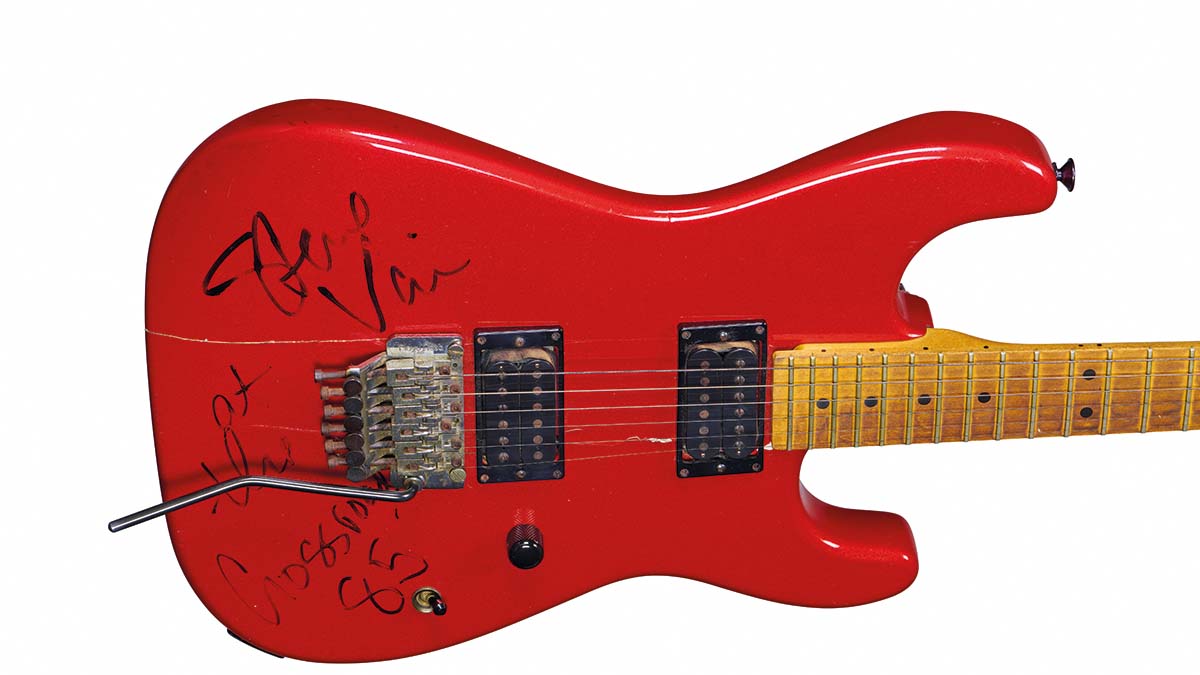
My matter-of-fact approach apparently worked because in a few weeks I received a new email from Queenstown that said “photos attached.” Here it was at last: three photos, front, side and rear, with the final key to the treasure vault, the serial number: 4708.
I triumphantly took my new-found information back to the Jackson Custom Shop and thought that they’d finally be able to track the guitar in their records – we’d have its specs and history. Wrong again! The Custom Shop said there was no record of the guitar, and it must have been made off the books. The serial number on the guitar’s plate was authentic, but for an entirely different Charvel from 1985.
It was the right year but the wrong guitar. Apparently, it was common practice for neckplates to be reused, perhaps when a guitar was destroyed or disassembled, and then used on another guitar. So the original Jack Butler guitar is officially and appropriately a ghost in the system. It never happened.
Some of the mystery did unravel when I took the serial number and confirmation of location back to the Hard Rock’s corporate office. They explained that it didn’t show up before because they were changing to a new record-keeping system and the guitar was being stored/maintained before being reallocated to the New Zealand location. The Hard Rock’s records also showed that they acquired it from none other than Norm’s Rare Guitars. This was no surprise, as rock stars frequently sell and trade guitars to Norm, who on occasion resells them to the Hard Rock.
Yes, it was only used as a movie prop, and I was well past the age of adolescent fascination. Still, it was a victory to finally have it in front of me after so many years of discovery and disappointment
Steve didn’t recall selling it to Norm, so it’s possible he just didn’t remember or gave the guitar to someone who later sold it to Norm. Ultimately, I wanted to directly inspect the instrument and shoot it for the magazine, but its location halfway around the world made this financially and logistically impossible. And I still didn’t know if they only had the copy or the real guitar.
Fast-forward approximately 10 years, and I’d all but given up hope that we might ever have a chance to properly document and catalog the instrument. Then it showed up again on the internet, this time at the Hard Rock Cafe & Casino Biloxi (Mississippi) – an appropriate home, given that the crossroads of legend were in that Deep South state. I contacted the Hard Rock, confirmed that it did indeed reside at the Biloxi location, then traveled there myself to see it.
Yes, it was only used as a movie prop, and I was well past the age of adolescent fascination. Still, it was a victory to finally have it in front of me after so many years of discovery and disappointment. Now all I had to do was convince the Hard Rock to let me remove it from the plexiglass display capsule and shoot it for the magazine.
But this time I couldn’t ask them to do it on faith. I needed an official thumbs-up from the magazine. It took another four years before this would come to fruition, and wouldn’t you know that just as the magazine and the HRC were both on board, the nation was shut down by a once-in-a-century pandemic.
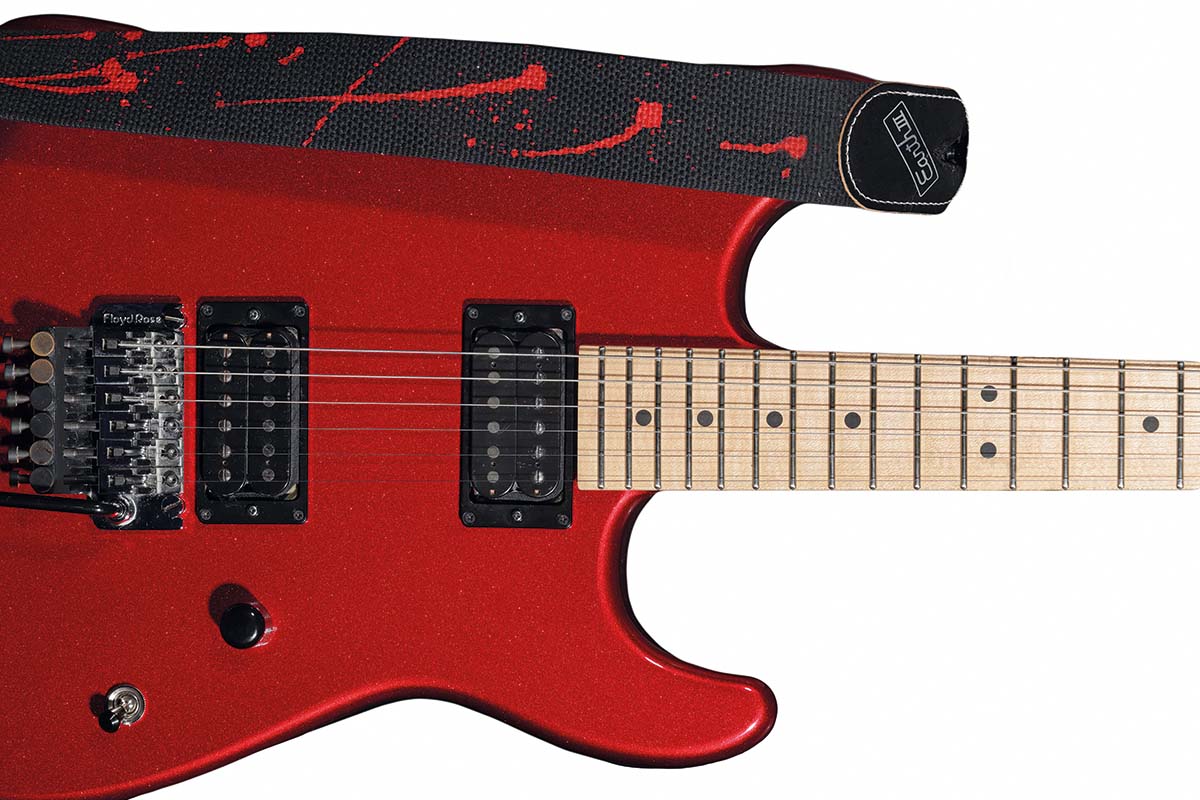
No surprise at all, the pandemic wasn’t the only barrier to crossing the finish line. The HRC simultaneously informed me that I was not the only person requesting to shoot the guitar. I couldn’t believe I might not only be stalled again, but potentially lose my story to another journalist!
My jaw clenched to suppress an indignant tone, I asked, “And may I inquire as to who this other person is?” “Sure,” they said, “It’s Steve Vai.” Well, that’s just great, I thought, Jack Butler himself was looking to reclaim his fire-born headcutter… how could I possibly compete with that? Okay, dramatic prose aside, it turned out that Vai was continuing to catalog his guitars through the years, as seen on his website, and wanted to have a closer look at this famed piece of his past.
Michael Mesker, Vai’s art director, and I were unknowingly working together... We struck a deal to have the guitar flown to L.A., where Mike could shoot it, and now finally have the first-ever high-resolution images of the only known surviving Jack Butler Jackson guitar
But what I assumed was a fresh disaster turned out to be sweet serendipity, because I soon learned that Michael Mesker, Vai’s art director, and I were unknowingly working together on separate parts of another project. We struck a deal to have the guitar flown to L.A., where Mike could shoot it, and now finally have the first-ever high-resolution images of the only known surviving Jack Butler Jackson guitar.
For all you gearheads out there, here are the specs: swamp ash body, quarter-sawn maple neck with a gunstock oil finish, 16-inch radius maple fretboard, woodscrew-top-mounted Floyd Rose tremolo, candy red sparkle finish (not red metal flake), 7.67 pounds, 1 11/16 -inch nut, Jackson J-90c bridge humbucker, Jackson J-80 neck humbucker, 22 jumbo frets, LP-style deep-well three-way switch with a fine-knurled nickel nut, Gotoh SG-36 tuners, black brass Charvel switch tip, oval-style Charvel input jack plate and a slim “C” neck profile measuring .792 inches at the nut tapering up to .845 inches at the 12th fret.
Dropping Copies
An unknown number of copies were made of the original guitar, so that Vai could convincingly drop his guitar in defeat without actually harming the real Jackson. Most of them were made by Jackson, and of these Grover said, “They didn’t even have a basecoat – they were just mockups.” None of these are known to have survived intact. But one copy was created that needed to essentially be identical. This is where Pat Wilkins and Steve Ripley entered the story.
Sadly, Ripley passed in 2019, but beforehand spoke to me about the project and shared anecdotally that it was one of his multi-output pickups that made it possible to capture the last symphonic chord of Eugene’s Trick Bag, the Paganini-inspired piece that ultimately sent Jack Butler to the guillotine.
This is another revelation, since fans have long questioned whether those last tones were added in post-production, accomplished with an octave pedal or created by pushing the strings against the Tele’s neck pickup. For anyone who doesn’t know Pat Wilkins, he’s painted and/or built guitars for a who’s-who of A-list players from the '70s to the present day.
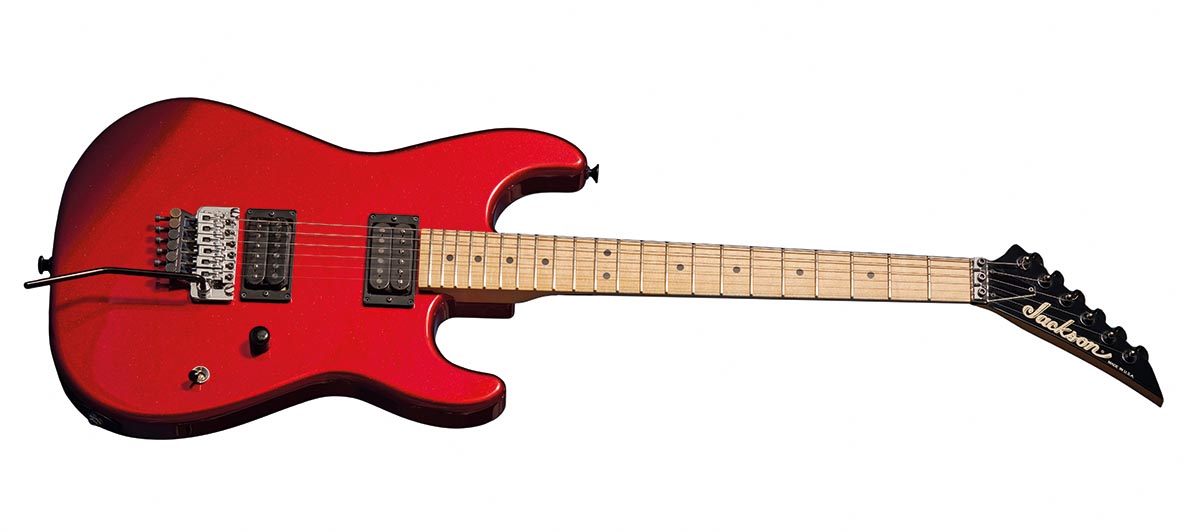
Here’s Pat’s recollection of the project with his best friend: “Steve Ripley was very well known as a musician and a producer. He did a tour or two with Bob Dylan and from there met a lot of top-end musicians. Vai may have met him through that connection. Or it was because Steve built many of the stereo guitars for players like Ry Cooder, EVH and producers like Phil Ramone.
“This I know for sure: during the filming and blocking out of the movie, the duel at the end required the Devil’s guitarist (Steve Vai) to drop his guitar and walk out in anger and frustration. Steve Ripley told me that Vai said there was no way he was going to drop his guitar, and that’s when it was decided to get a mockup made.
Even though the original guitar was an early Charvel, Steve used a Kramer body that he had lying around for the mockup
“My guess is that since Ripley had made over a dozen guitars for Ry, he probably suggested to Vai that he ask Ripley to make it for him. I was doing all the Ripley finishes, so he came to me with the request to copy the original. I know we had the original in-hand when we matched up the colors, and Ripley was very hands-on about getting it right enough to fool the cameras – I guess he knew about that, too.
“He was really a brilliant man. We did a 24-hour shift to get this right, because they were filming in three days and that’s all the time we had to finish this up. I had an old refrigerator that I put a 100-watt bulb in. I put a big dowel rod inside and hung the body in there to force-dry everything. It was tricky to get it right. That’s what I remember about the guitar and its history.
“Oh, and even though the original guitar was an early Charvel, Steve used a Kramer body that he had lying around for the mockup. Steve was doing Kramer/Ripley guitars at the time and had a huge stack of Kramer bodies that were just going to waste. He found one that looked like the Charvel model and we finished that.”
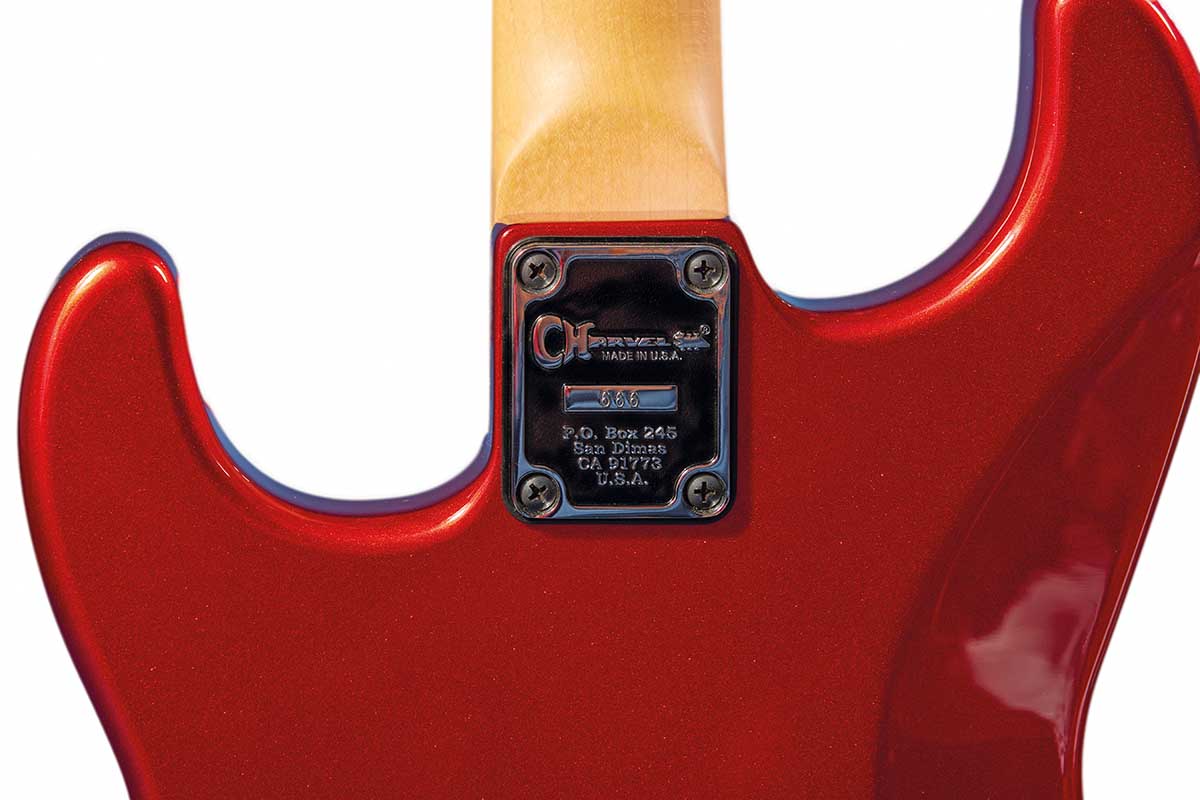
This leaves one last question to answer: is the Hard Rock’s guitar the original Jackson or the Wilkins/Ripley copy? The answer is that this is indeed the real guitar and that Walter Hill must have run out of copies to drop. In some of the final scenes of Vai playing, cracks in the body and finish are evident. Arlen Roth said, “Hill would never have used these shots unless it was the last guitar to shoot.”
Furthermore, it’s highly unlikely that Ripley/Wilkins had a real Jackson neck, and he always shot his candy paint on a silver base coat, not the white base coat apparent on the Hard Rock’s guitar.
Recreating the Devil’s Guitar
Early into my research, I naively thought it would be fun and reasonably simple to build an exact replica of the Jack Butler Jackson. After all, I’m an accomplished guitar tech, and I had the help of professionals who were far more skilled than me, including Mike Shannon at Jackson’s Custom Shop, Pat Wilkins, Nick Scout at Scout Guitars and Mitch at KNE Guitars. How hard could it be to assemble a simple two-humbucker Charvel-style body with a Jackson neck and a Floyd Rose trem?
The Jackson Custom Shop created a real San Dimas neck plate and had the custom serial number “666” laser etched into it. I was told it’s the only custom serial number ever officially issued by Charvel/Jackson
But, pun intended, the devil’s definitely in the details. Looking back, I don’t know what was more difficult: rebuilding the guitar or finding the original. A huge part of the challenge was sourcing exact-year parts. It took me many years to find them, but every single piece of hardware on this replica is from 1985, with the exception of the neck plate.
When I was working with the Jackson Custom Shop, the manager suggested we do something special. So they created a real San Dimas neck plate (this is before the San Dimas plates were reissued) and had the custom serial number “666” laser etched into it. Not only is it wicked-appropriate to the theme, I was told it’s the only custom serial number ever officially issued by Charvel/Jackson. Mike Shannon at the Jackson Custom Shop built me my first attempt at this guitar – unfortunately before I had all of the correct information, parts and formula for the finish.
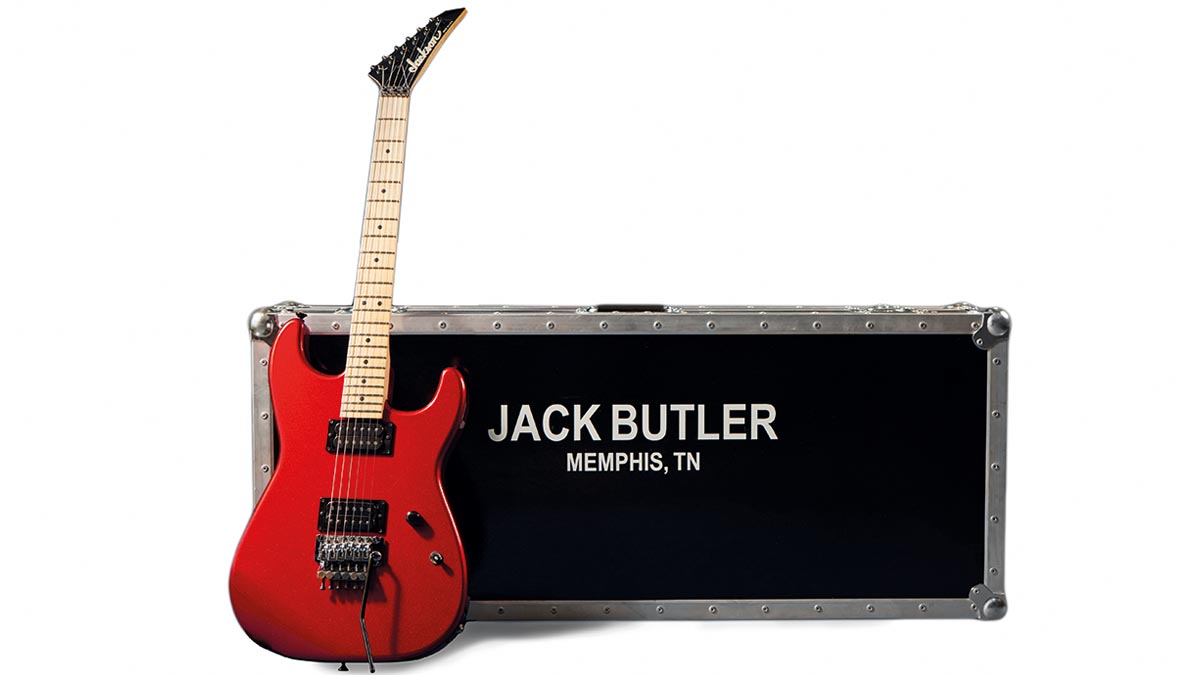
He even rebuilt it for me a second time because the first one’s specs got mixed up with a guitar being built alongside mine – for none other than Eddie Van Halen. The guitar he created was astounding in every way, but it ultimately had to be redone a third time because of my own incorrect information.
By the time I got around to building this final version, Shannon was semi-retired. I reused the Shannon neck but turned to KNE Guitars for the body, possibly the only shop outside of Charvel/Jackson that currently cuts precisely correct San Dimas bodies. He selected a very special piece of Swamp Ash, only 3.6 pounds, that we edged with a slightly sharper than 3/8-inch roundover.
I went back to Pat Wilkins for the finish, since he painted the only copy to get close-up screen time and said that he still remembered the original formula. It’s important to note that every replica I’ve seen has been shot with a heavy flake. In actuality, the original was a candy red sparkle, meaning there were silver micro sequin flakes mixed into the paint.
This is why the original guitar doesn’t appear to have any flake or sparkle until it’s turned in the light – a detail that is only seen a couple times on the film’s dark stage.
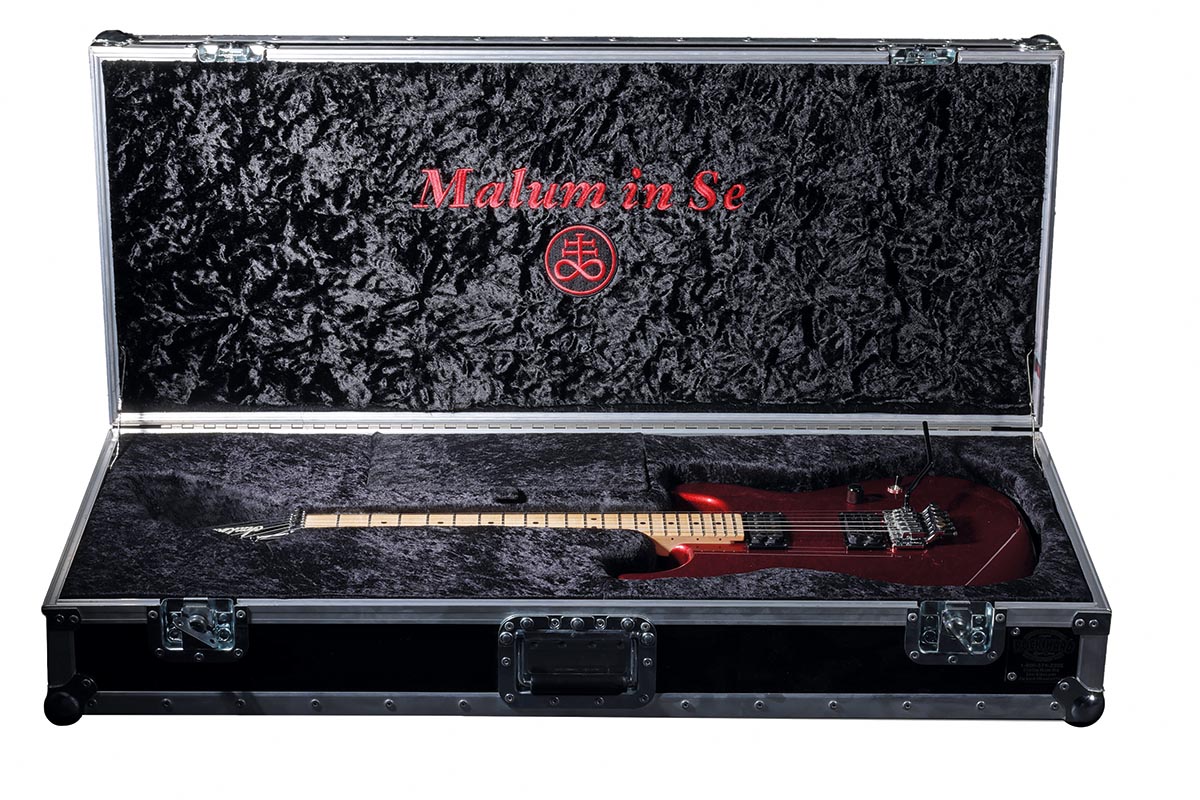
The final color of my recreation appears slightly deeper and darker, because the original guitar’s paint has faded considerably over 35 years. Then there was one more surprise in store for me, and this time a pleasant one. When I approached Pat Wilkins about painting my replica, he said, “You’re in luck. I just happen to have a little jar of the original silver sequin flake that I used on the first Crossroads guitar in 1985. I have just enough to do one body and I can’t get any more of it.
This very special flake came from a shop that used to be in Canoga Park, right off Sherman Way. They were cutting and making the pearls in a three-bedroom home that had been completely gutted – there was pearl all over the floor and lawn. It was a complete mess, but they made it all custom while you waited.
I think the neighbors finally called the EPA or the cops because I drove back one day to pick up a bunch more pearl and flake and there was no one there. Bummer!”
Two custom cases were commissioned for my replica: a flight case from Rock Hard Cases and an Italian leather-covered case from G&G.
Of course, it wouldn’t be complete without a new blood-splatter strap from the Earth III Guitar Strap Co. (the same that Vai used in the film). It’s a phenomenal one-of-a-kind instrument, even without the story, and, for me, the unabashed realization of a childhood dream.
That’s a Wrap
To put this in perspective, the Jack Butler Jackson was never used as anything more than a movie prop. It truly is the most famous guitar that was never heard. But it meant so much more to starry-eyed, teenage moviegoers.
It inspired many careers in music and ultimately became symbolic of a generation that pushed the limits of technical and musical expression. To the next generation, I say, “Who’s next up there? Hmm? Who’s coming on up? Who’s gonna get their head cut?!”
“It holds its own purely as a playable guitar. It’s really cool for the traveling musician – you can bring it on a flight and it fits beneath the seat”: Why Steve Stevens put his name to a foldable guitar
“Finely tuned instruments with effortless playability and one of the best vibratos there is”: PRS Standard 24 Satin and S2 Standard 24 Satin review









